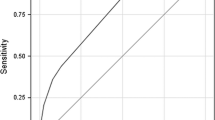Abstract
Background
The identification of distinct molecular subtypes has changed breast cancer management. The correlation between mammographic appearance and molecular subtype for invasive breast cancer has not been extensively studied.
Methods
A retrospective review of our prospectively collected database was performed to evaluate the mammographic appearance and molecular subtypes of all cases of invasive breast cancers diagnosed between 2003 and 2010.
Results
There were 985 cases of invasive breast cancer with complete data on receptor status and mammographic appearance. The most common mammographic finding was a mass (61 %), and the most common molecular subtype was ER/PR positive, HER2 negative (71 %). On univariate analysis, race, stage, and histology were all significantly associated with molecular subtype. On multivariate analysis, the luminal molecular type was associated with architectural distortion [odds ratio (OR) 4.3, 95 % CI 1.3–14.1]; HER2 positive cancers, either with or without ER/PR expression, were more likely to be associated with mammographic calcifications (OR 2.8 and 3.1, respectively; 95 % CI 1.7–4.8 and 1.7–5.5); and triple negative cancers were most likely to be associated with a mammographic mass (OR 2.5; 95 % CI 1.4–4.4).
Conclusions
We observed several characteristic associations between molecular subtype and mammographic appearance. Improved understanding of these associations may help guide clinical decision making and provide information about underlying tumor biology.
Similar content being viewed by others
References
Jiang L, Ma T, Moran MS, Kong X, Li X, Haffty BG, et al. Mammographic features are associated with clinicopathological characteristics in invasive breast cancer. Anticancer Res. 2011;31:312327–34.
Breyer JP, Sanders ME, Airey DC, Cai Q, Yaspan BL, Schuyler PA, et al. Heritable variation of ERBB2 and breast cancer risk. Cancer Epidemiol Biomarkers Prev. 2009;18:1252–8.
Gonzalez-Angulo AM, Litton JK, Broglio KR, Meric-Bernstam F, Rakkhit R, Cardoso F, et al. High risk of recurrence for patients with breast cancer who have human epidermal growth factor receptor 2-positive, node-negative tumors 1 cm or smaller. J Clin Oncol. 2009;27:5700–6.
Heuser LS, Spratt JS, Kuhns JG, Chang AF, Polk HC Jr, Buchanan JB. The association of pathologic and mammographic characteristics of primary human breast cancers with “slow” and “fast” growth rates and with axillary lymph node metastases. Cancer. 1984;53:96–8.
Wang X, Chao L, Chen L, Tian B, Ma G, Zang Y, et al. Correlation of mammographic calcifications with Her-2/neu overexpression in primary breast carcinomas. J Digit Imaging. 2008;21:170–6.
Ferranti C, Coopmans de Yoldi G, Biganzoli E, Bergonzi S, Mariani L, Scaperrotta G, et al. Relationships between age, mammographic features and pathological tumour characteristics in non-palpable breast cancer. Br J Radiol. 2000;73:698–705.
Evans AJ, Pinder SE, Ellis IO, Sibbering DM, Elston CW, Poller DN, et al. Correlations between the mammographic features of ductal carcinoma in situ (DCIS) and C-erbB-2 oncogene expression. Nottingham Breast Team. Clin Radiol. 1994;49:559–62.
Wang Y, Ikeda DM, Narasimhan B, Longacre TA, Bleicher RJ, Pal S, et al. Estrogen receptor-negative invasive breast cancer: imaging features of tumors with and without human epidermal growth factor receptor type 2 overexpression. Radiology. 2008;246:367–75.
Kim SH, Seo BK, Lee J, Kim SJ, Cho KR, Lee KY, et al. Correlation of ultrasound findings with histology, tumor grade, and biological markers in breast cancer. Acta Oncol. 2008;47:1531–8.
Foulkes WD, Stefansson IM, Chappuis PO, Bégin LR, Goffin JR, Wong N, et al. Germline BRCA1 mutations and a basal epithelial phenotype in breast cancer. J Natl Cancer Inst. 2003;95:1482–5.
Nofech-Mozes S, Trudeau M, Kahn HK, Dent R, Rawlinson E, Sun P, et al. Patterns of recurrence in the basal and non-basal subtypes of triple-negative breast cancers. Breast Cancer Res Treat. 2009;118:131–7.
Rakha EA, Reis-Filho JS, Ellis IO. Basal-like breast cancer: a critical review. J Clin Oncol. 2008;26:2568–81.
Haffty BG, Yang Q, Reiss M, Kearney T, Higgins SA, Weidhaas J, et al. Locoregional relapse and distant metastasis in conservatively managed triple negative early-stage breast cancer. J Clin Oncol. 2006;24:5652–7.
Ko ES, Lee BH, Kim HA, Noh WC, Kim MS, Lee SA. Triple-negative breast cancer: correlation between imaging and pathological findings. Eur Radiol. 2010;20:1111–7.
Disclosure
None.
Author information
Authors and Affiliations
Corresponding author
Rights and permissions
About this article
Cite this article
Killelea, B.K., Chagpar, A.B., Bishop, J. et al. Is There a Correlation Between Breast Cancer Molecular Subtype Using Receptors as Surrogates and Mammographic Appearance?. Ann Surg Oncol 20, 3247–3253 (2013). https://doi.org/10.1245/s10434-013-3155-7
Received:
Published:
Issue Date:
DOI: https://doi.org/10.1245/s10434-013-3155-7




